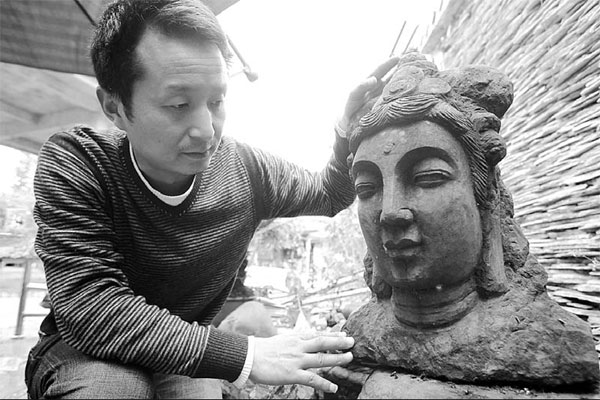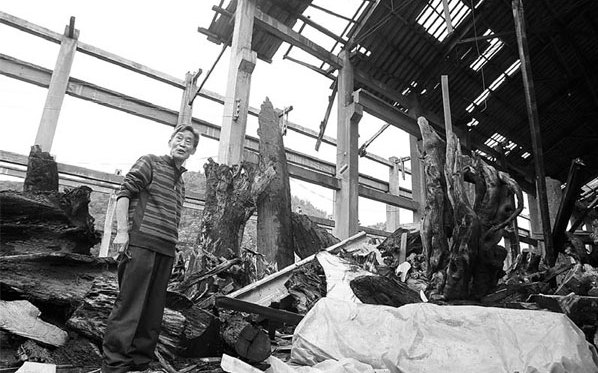Going back to root causes
Updated: 2013-06-13 07:36
By Deng Zhangyu (China Daily)
|
||||||||

|
Liu Yiheng, owner of Daziran root carving factory in Lushan county, shows a carved Buddha which was damaged during the quake. Photos by Zhu Xingxin / China Daily |
|
Liu Dazhong, 70, Liu Yiheng's father, visits the ruins of the family's root carving factory. |
When disaster strikes, some things must be put on hold. In Sichuan, the recent earthquake shattered many lives, and also damaged a time-honored craft. Deng Zhangyu reports from Lushan county.
The drive for profit often comes before all else, but in the face of disaster, it has to take a backseat as people's priorities shift from making money to rebuilding their devastated lives. Such is the case in Lushan county in Sichuan province where a maganitude-7 quake hit in April.
In a street lined with hundreds of root carving shops, piles of muted dark ebony wood lie neglected.
This is not just any wood, but a semi-fossilized species of local hardwood that has been lying at the bottom of the great rivers for thousands of years. They are mainly found in Sichuan province, especially in areas not far away from Lushan.
In Lushan, carvings displayed in shop windows along the "root-carving street" are all made from this precious wood, which has been turned into tea sets, decorative sculptures and furniture.
Residents here are proud that this is the biggest ebony-root carving market in China.
Now, however, they are concentrating on rebuilding their ruined homes. The root carving industry will have to wait its turn to be revived.
"Some workers at my factory have gone home to rebuild their houses. I've been busy repairing my shop and factory since the quake," says Wang Linkang, standing by a pile of ebony at the factory behind his shop.
The walls of his factory had collapsed. The walls of the display section of his shop had cracked. Many of his carvings were also damaged during the quake.
Lushan was above the epicenter of the quake and was subsequently the worst hit.
The root carvings at Wang's shop cost from several thousand to hundreds of thousands yuan. Most items averaged about 40,000 yuan ($6,500), says the 43-year-old entrepreneur.
Wang has been in business for more than 10 years, and he says the boom only came about two years ago when the demand for the ebony carvings started soaring. Business had been especially good this year before the quake hit.
"The quake destroyed it. Our clients will not come. People involved in the business have to rebuild their houses first," says Wang, whose factory has about 10 workers.
Wang bends down and picks up a piece of ebony at his feet. "The better it smells, the better the quality."
He says a piece of quality wood can produce from one to several carvings depending on the size and shape.
Not far away from Wang's shop is one of the biggest root carving factories in Lushan - Daziran.
The factory's four-storey exhibition hall built along a river is on the verge of collapsing. Ruined root carvings were scattered everywhere.
Owner Liu Yiheng had learnt to carve from his father while still a teenager. It is a family business and he is now the fourth generation.
"Lushan is known for its root carving arts and crafts. The revenue from the whole industry reached 1 billion yuan last year," says Liu, who is also the chairman of the Root Carving Association of Lushan.
The art of carving dates back to the Eastern Han Dynasty (AD 25-220). At that time, the material used was mainly stone, but due to the rich store of rare ebony buried underground and in the rivers in Sichuan province, people turned to root carving. In recent years, the rareness of the wood and the excellence of the craftsmanship led to increased popularity for Lushan ebony carvings.
Liu's factory has more than 80 workers, among whom less than 20 are skilled craftsmen. Now most of them have returned home to rebuild their houses and only those living nearby stayed to help repair the factory.
"A penholder was priced at 30,000 yuan. Now it's broken. After we repair it, it will cost less than 10,000 yuan," says Liu.
The penholder he was referring to is made with the most precious of the ebonies - jinsi nanmu, also called golden thread wood for its fine golden grain. It is always in much demand.
Luo Zhirong is dedicated to searching out hidden and buried pieces of jinsi nanmu. She says the precious woods are frequently found in paddy fields and deep riverbeds. But it is the rare day when one can find a good specimen.
"If we are lucky to find one, we can sell it for half a million yuan," says Luo, standing besides her temporary tent. Her house at the county center is too damaged to live in.
Luo says the quake stopped her search. She has no house to live in, so for the next months at least, building a new house is on top of her agenda.

Along the street where 230 root carving shops congregate, only a few shops have opened for business, even though they are still pretty much in shambles.
"We may have to wait for at least half a year or even one year for full recovery, but we must face disaster with confidence," says Liu Yiheng, the owner of Daziran. Both of his two factories were significantly damaged, but he decided to stay open for business.
"Opening my shop is to send out a message of confidence to others," says Liu.
Contact the writer at dengzhangyu@chinadaily.com.cn.
(China Daily USA 06/13/2013 page10)

 Michelle lays roses at site along Berlin Wall
Michelle lays roses at site along Berlin Wall
 Historic space lecture in Tiangong-1 commences
Historic space lecture in Tiangong-1 commences
 'Sopranos' Star James Gandolfini dead at 51
'Sopranos' Star James Gandolfini dead at 51
 UN: Number of refugees hits 18-year high
UN: Number of refugees hits 18-year high
 Slide: Jet exercises from aircraft carrier
Slide: Jet exercises from aircraft carrier
 Talks establish fishery hotline
Talks establish fishery hotline
 Foreign buyers eye Chinese drones
Foreign buyers eye Chinese drones
 UN chief hails China's peacekeepers
UN chief hails China's peacekeepers
Most Viewed
Editor's Picks

|

|

|

|

|

|
Today's Top News
Shenzhou X astronaut gives lecture today
US told to reassess duties on Chinese paper
Chinese seek greater share of satellite market
Russia rejects Obama's nuke cut proposal
US immigration bill sees Senate breakthrough
Brazilian cities revoke fare hikes
Moody's warns on China's local govt debt
Air quality in major cities drops in May
US Weekly

|

|









